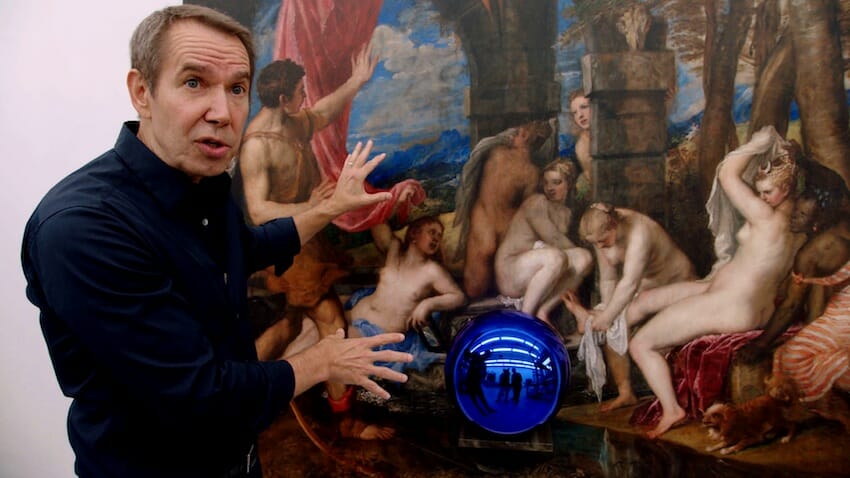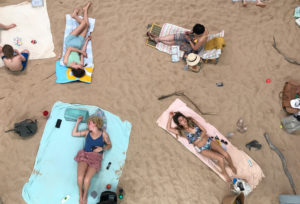‘The Price of Everything’ Confronts an Art World Awash With Cash
Filmmaker Nathaniel Kahn and a "Guerrilla Girl" contemplate cultural representation amid scorched-earth capitalism, as artists like Jeff Koons (pictured) make bank in a speculative art market. Jeff Koons stands before an artwork in this still from the film "The Price of Everything." (ThePriceofEverything.com)
Jeff Koons stands before an artwork in this still from the film "The Price of Everything." (ThePriceofEverything.com)
In Oscar Wilde’s satirical play “Lady Windemere’s Fan,” the shrewd Lord Darlington notes that a cynic is a “man who knows the price of everything and the value of nothing.” From Wilde’s tip, filmmaker Nathaniel Kahn takes the title for his new documentary about an art market besieged by end-stage capitalism, “The Price of Everything,” in theaters beginning Oct. 19, and on HBO Nov. 12.
The rich and powerful have always dominated the art market, making wealthy men of artists like Rubens, Rembrandt and Michelangelo, who all ran bustling ateliers and raked in high commissions. What’s changed is the speculative market surrounding the art world. No doubt, many among the powerful and influential have commissioned works in the past with an understanding that the works would increase in value over time. But today’s market is driven by speculation, with buyers bidding on artworks as if from the floor of the stock exchange.
“Art has always shown us who we are. Art holds the mirror up to us and tells us to look at how our society is beginning to [substitute the price of something for] its intrinsic value. And this is the darker edge of capitalism that I very much want to explore in this film,” Kahn tells Truthdig.
“Never before has there been this incredibly intense use of art as a financial instrument. We now live in a period where everything in our world is commodified,” Kahn adds about his latest outing, which features gallerists and curators as well as artists Larry Poons, Marilyn Minter, George Condo and Jeffrey Koons—a commodity broker turned creator of Mylar balloon animals reimagined in stainless steel who offers futures on his work. A collector may purchase the promise of a future work, which she or he can hold to maturity or sell to other interested parties.
Though Jackson Pollock’s wife, Lee Krasner, was able to demand unusually exorbitant prices for her husband’s work following his death in 1956, the market hit a turning point with the Scull auction of 1973, with a focus on living artists like Jasper Johns, Robert Rauschenberg, Frank Stella, Franz Kline and others from the period. A taxicab impresario and backer of the Green Gallery, which under director Richard Bellamy had immediate connections to New York’s most prominent living artists, Robert Scull sold many artworks for exponentially higher prices than what he paid for them.
A painting by Cy Twombly, purchased for $750, sold for $40,000. And Johns’ “Double White Map” fetched $240,000, considerably more than its purchase price of only $10,200. Rauschenberg, whose “Thaw” combine was acquired for a mere $900, sold for $85,000, prompting the artist to confront Scull. In archival footage of the auction included in Kahn’s film, Scull good-naturedly tells Rauschenberg that high prices will eventually benefit the artist.
At one point, Scull looks at a painting by Larry Poons and notes that he hasn’t seen it since he purchased it, indicating he’s held it in storage for the amount of time he’s had it, which suggests the painting was purchased as an investment. “He brings it out and doesn’t really recognize how good it is until it’s being sold,” Kahn says. “This is the moment where things begin to get a little hairy. The idea of being a speculative instrument; that’s the key moment.”
Seen wandering through a gallery in the film, Gerhard Richter laments the rising prices of artworks, including his own. “It’s not good when this is the value of a house. It’s not fair,” he says. “I like it, but it’s not a house. Money’s dirty.”
Richter, whose “Abstraktes Bild” set a record for second highest price to a living artist in 2015 when it sold for $46.3 million, goes on to say he would prefer his works be donated to a museum, where the public might enjoy them. But with entry prices going up in places like MoMA and LACMA, the public is becoming increasingly alienated from the art world. Moreover, it is customary for museums to display a mere 5 percent of their collection at any given time.
“It’s a very socialist-democratic way of avoiding having to deal with rich people who want them,” is Sotheby’s Fine Arts Chairman Amy Cappallezzo’s response to Richter. She is shown prepping a big auction, and even taking bids over the phone. Practices called “irrevocable bids,” in which a party bids before the sale and, if the sales price is above that figure, receives a percentage, and “chandelier bids,” when an auctioneer acknowledges a bid that was never offered, have created profound skepticism around auction houses.
For many, that skepticism was further stoked when Banksy’s “Girl With Balloon” made headlines, selling for $2.1 million at Sotheby’s Contemporary Art Auction coinciding with London Frieze, then proceeded to drop through the bottom of the frame in which a hidden shredder was embedded, leaving most of the work in canvas strips.
While many marveled at the anonymous street artist’s ability to change a work and its meaning on cue, others wondered why, if there was no forehand knowledge, the painting wasn’t placed on an easel, as per usual, but hung on the wall, facilitating the stunt. Never mind the fact that it seems unlikely that Banksy built the shredding frame in 2006 and it sat undetected for 12 years before being remotely activated at the point of sale, actually doubling the painting’s value.
To artist Marilyn Minter that represents “white heat,” which, in the film, she defines as “when a painting sells for over $1 million and you’re still alive.” It’s a point taken up by the Guerrilla Girls, an all-female anonymous protest group usually seen wearing gorilla masks. Since their formation in 1985, they have made a project of singling out the art-world patriarchy and the exclusion of women and artists of color.
“Don’t let museums reduce art to a small number of artists who have won a popularity contest among bigtime dealers, curators and collectors,” says Guerrilla Girl Kathe Kollwitz, a founding member who has taken the name of a 1920s German expressionist artist to protect her identity. “If museums don’t show art as diverse as the cultures they claim to represent, tell them they’re not showing the history of art. They’re just representing the story of wealth and power.”
Many of the most prominent collectors, like Eli Broad or Stefan Edlis, who is featured in the film, collect the usual white male artists—Koons, Warhol and Hirst. Frequently, they also serve on the board of major museums, playing an important decision-making role regarding which artists are acquired. The result is that museums, which are historical cultural repositories, reflect an unbalanced picture of which artwork matters and which do not.
“I really do worry when I see our cultural institutions manipulated by money. There is so much great art out there being made by artists who are either from places that are not being collected from by prominent collectors, or they don’t have the right gallery behind them or they don’t have the right advocates,” Kahn says. “Those voices are oftentimes not making it into our cultural institutions. These are voices that must be heard.”
And, to a limited degree, they are being heard. L.A.-based Nigerian artist Njideka Akunyili Crosby (featured in the film) sold “Bush Babies” at Sotheby’s earlier this year for $3.4 million. And the Hammer Museum, whose biennial “Made in L.A.” show spotlights emerging local artists, included an overwhelming majority of women, LGBTQ people and artists of color among the roughly 30 practitioners showcased in its most recent iteration.
“We’ve seen a lot of progress,” notes Kollwitz, who likens changing major art institutions to turning a battleship mid-ocean. “Certainly, at the entry level at galleries, and to some extent the museums, there are more women and artists of color than ever before. It’s happening,” she says. “The problem is, if you do the numbers, it’s not happening enough. I think many institutions have started to realize that the main problem for them is they’re stuck with their collection, which is all male white artists. They’re trying to rectify that.”
Kahn doesn’t worry about art; he worries about us. Art will continue reflecting who we are, for better or for worse. “Ultimately, we are the arbiters of what art will speak for us in our time. And people need to take back that power,” he says. “The film encourages people to go and look at art again, and trust their own feelings about it rather than what the paper says about what something is worth. Trust your own eyes and you decide what art is worth your time and your engagement,” he implores. “If you’re feeling alienated by the way art is being treated now, that’s a good sign. You should feel alienated. But art isn’t alienating. Money is distancing us from art. That’s art telling us that money is alienating us from our humanity.”
Your support matters…Independent journalism is under threat and overshadowed by heavily funded mainstream media.
You can help level the playing field. Become a member.
Your tax-deductible contribution keeps us digging beneath the headlines to give you thought-provoking, investigative reporting and analysis that unearths what's really happening- without compromise.
Give today to support our courageous, independent journalists.






You need to be a supporter to comment.
There are currently no responses to this article.
Be the first to respond.